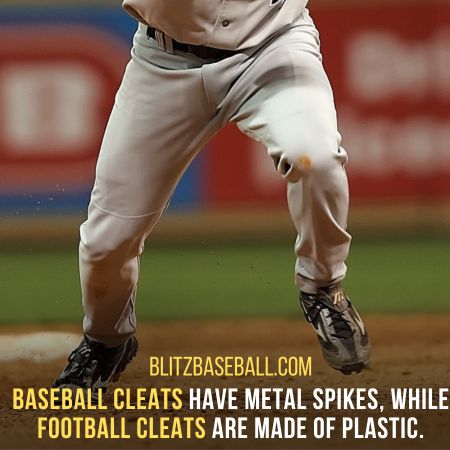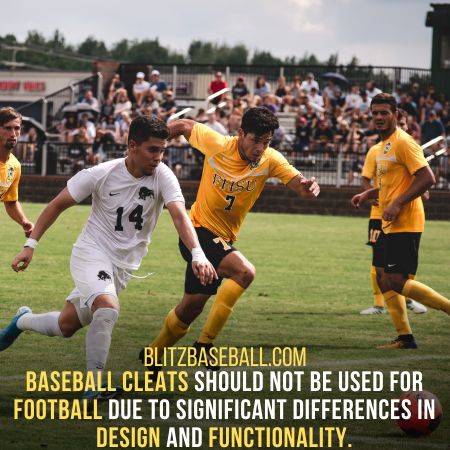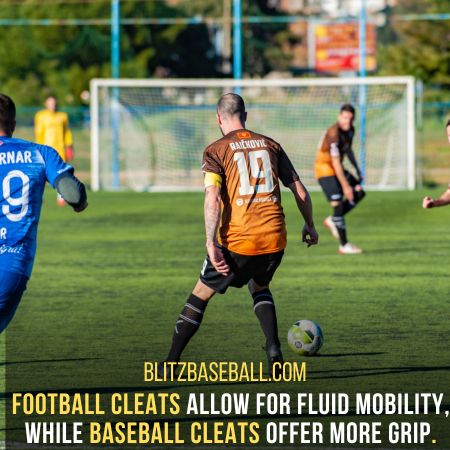Baseball cleats and football cleats are specialized footwear designed for specific sports, each with its own distinct features and purposes. So, can you use baseball cleats for football?
While both cleats are intended to provide traction and support on the field, they differ significantly in design and functionality. Baseball cleats feature metal spikes that offer superior grip, whereas football cleats are typically made of plastic.
Additionally, football cleats provide support in multiple directions and offer more ankle support due to the higher risk of ankle injuries in football.
It is important to note that in most youth and amateur football leagues, the use of metal cleats is prohibited for safety reasons.
Therefore, using baseball cleats for football is not recommended, as it can compromise performance and potentially lead to injuries.
Understanding the differences between these cleats and using the appropriate footwear for each sport is crucial to ensure optimal performance and safety on the field.
Key Takeaways
- Baseball cleats have metal spikes, while football cleats are made of plastic.
- Football cleats allow for fluid mobility, while baseball cleats offer more grip.
- Baseball cleats should not be used for football due to significant differences in design and functionality.
- It is recommended to use specific cleats for each sport for better performance.
Football Cleat Types
Football cleats can be categorized into two types: molded and detachable, with molded cleats being made of plastic and considered the superior option.
Molded football cleats are commonly used due to their durability and versatility. They provide good traction on various playing surfaces and are suitable for the hardest positions. The plastic material offers increased comfort and affordability compared to other options.
The rubber molded cleats, in particular, provide a balance between comfort and traction. They are ideal for players who prioritize comfort during extended periods of play.
On the other hand, hard molded cleats are made of tough plastic and provide excellent traction and comfort.
Detachable football cleats offer the advantage of customizability, allowing players to change studs according to field conditions. However, they require additional maintenance and may not be as durable as molded cleats.

Differences in Design
The design of baseball cleats differs from that of football cleats in several ways. One key difference lies in the importance of grip. Baseball cleats are designed to provide maximum grip on the ground, allowing players to make quick lateral movements and maintain stability while running bases.
In contrast, football cleats prioritize performance in different field conditions. Football players encounter a variety of surfaces, such as grass, turf, and even muddy fields.
As a result, football cleats are designed to provide traction and support in all directions, enabling players to change direction quickly and maintain balance on different surfaces.
Additionally, the design of football cleats takes into account the increased risk of ankle sprains in the sport, providing additional support and stability to protect players during intense gameplay.
Can You Use Baseball Cleats For Football?
When considering the suitability of baseball cleats for the sport of football, it is important to acknowledge the significant differences in design and functionality between the two types of cleats.
Advantages:
- Baseball cleats offer more grip due to their sharper spikes, which can be advantageous for traction on grassy surfaces.
- They also have more cushioning and comfort in the midsole, providing additional support during gameplay.
Disadvantages:
- Baseball cleats are designed for forward motion, lacking the support needed for the multidirectional movements required in football.
- Additionally, metal spikes, commonly found in baseball cleats, are not allowed in football due to safety concerns.
Safety considerations:
- Football cleats are specifically designed to provide support and stability in all directions, reducing the risk of ankle sprains.
- Baseball cleats, on the other hand, may not offer the same level of ankle support required for football gameplay.

Considering these differences, it is not recommended to use baseball cleats for football due to the potential safety risks and the lack of optimal performance.
Comparison with Soccer Cleats
In comparing baseball cleats to soccer cleats, it is important to consider their differences in design and functionality. Baseball cleats are designed with sharper spikes for more traction on the field, while soccer cleats have rounded spikes for speed and agility.
This difference in spike design makes baseball cleats less suitable for football, as they may not provide the necessary traction and support needed for quick changes in direction and lateral movements.
Additionally, soccer cleats do not have extra cleats and spikes at the front, unlike baseball cleats. The table below summarizes the key differences between baseball and soccer cleats for football:
| Baseball Cleats | Soccer Cleats |
|---|---|
| Sharper spikes for more traction | Rounded spikes for speed and agility |
| Extra cleats and spikes at the front | No extra cleats and spikes at the front |
| Not ideal for quick changes in direction and lateral movements | Suitable for speed and quick movements |
| May lack necessary traction and support for football | May not provide optimal performance for football |
When considering the use of baseball cleats for football, it is important to weigh the pros and cons. While baseball cleats with interchangeable cleats may be used, the performance may not be optimized due to the differences in spike design.
It is generally recommended to use specific cleats designed for each sport to ensure better performance and safety.
Optimal Performance Considerations
Optimal performance considerations must be taken into account when selecting appropriate footwear for sports activities. When comparing baseball cleats to football cleats, it is important to weigh the pros and cons and consider their impact on performance.

Pros of using baseball cleats for football:
- Baseball cleats offer more grip due to their sharper spikes, which can be advantageous for certain football positions that require quick cuts and changes in direction.
- Some baseball cleats have interchangeable cleats, allowing players to switch between molded and metal soles, which can provide versatility on different playing surfaces.
Cons of using baseball cleats for football:
- Baseball cleats are designed for forward motion and may not provide the necessary support for the multidirectional movements required in football.
- Metal cleats, commonly found in baseball cleats, are not permitted in football due to safety concerns.
- The weight and cushioning of baseball cleats may not be optimized for football, potentially impacting speed and agility.
Considering these factors, it is generally recommended to use sport-specific cleats for optimal performance in each respective sport.
Frequently Asked Questions
Are metal cleats allowed in football?
Metal cleats are not allowed in football due to safety concerns. Instead, football players typically use molded cleats made of plastic. The use of metal cleats can increase the risk of injury to both the player wearing them and other players on the field.
Can football cleats be used for baseball?
Football cleats should not be used for baseball due to their design and lack of traction on different surfaces. Baseball cleats have sharper spikes and offer more grip, which is essential for baseball’s lateral movements and quick stops.
What is the difference between football and soccer cleats?
Differences in design between football and soccer cleats include the presence of toe spikes in football cleats and the absence of extra cleats and spikes at the front in soccer cleats. Soccer cleats should not be used for rugby.
Are baseball and softball cleats the same?
Baseball and softball cleats are similar in design and feature spikes on the toes for traction. However, football cleats are not recommended for baseball as they lack the necessary spikes for optimal traction and performance.
Can baseball cleats be used for flag football?
Using baseball cleats for flag football may have some advantages such as increased grip and traction. However, potential drawbacks include reduced running speed and the lack of specific features designed for football, such as toe studs and rounded spikes.
Conclusion
In conclusion, baseball cleats and football cleats are designed with distinct features and purposes in mind.
Baseball cleats have metal spikes, offer more grip, and are not suitable for football due to safety regulations.
Football cleats, on the other hand, have plastic spikes, provide support in all directions, and have more ankle support.
It is not recommended to use baseball cleats for football due to significant differences in design and function.
It is crucial to use specific cleats for each sport to optimize performance.
